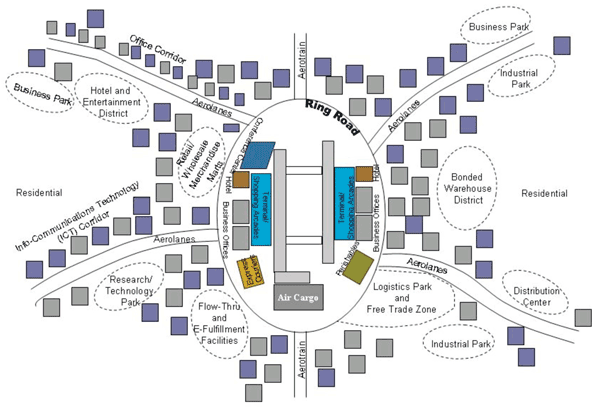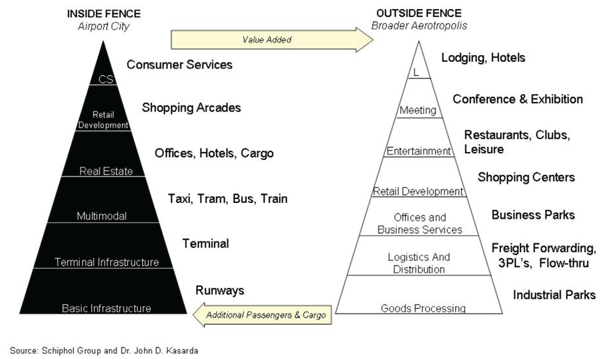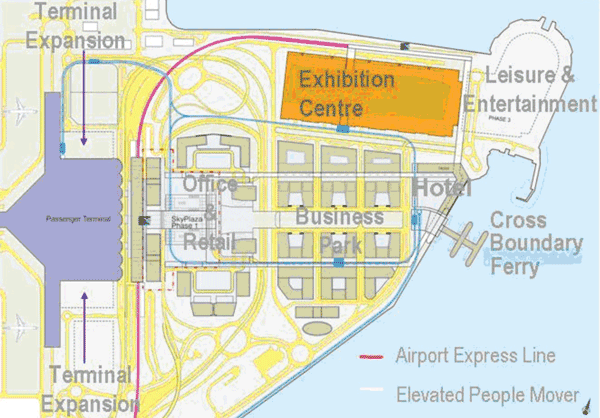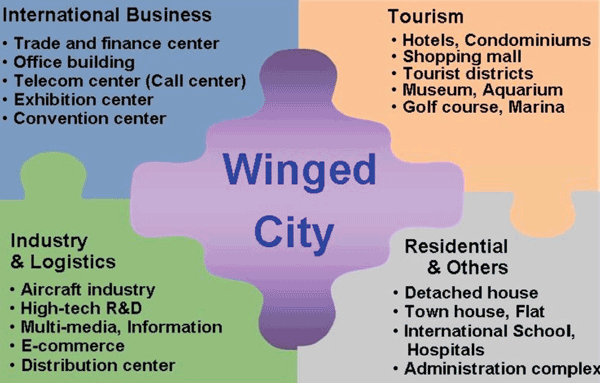Asia’s emerging airport cities
- Like
- Digg
- Del
- Tumblr
- VKontakte
- Buffer
- Love This
- Odnoklassniki
- Meneame
- Blogger
- Amazon
- Yahoo Mail
- Gmail
- AOL
- Newsvine
- HackerNews
- Evernote
- MySpace
- Mail.ru
- Viadeo
- Line
- Comments
- Yummly
- SMS
- Viber
- Telegram
- Subscribe
- Skype
- Facebook Messenger
- Kakao
- LiveJournal
- Yammer
- Edgar
- Fintel
- Mix
- Instapaper
- Copy Link
Posted: 16 June 2006 | Dr. John D. Kasarda, Director, Kenan Institute of Private Enterprise, University of North Carolina | No comments yet
Demand, competition and opportunity in Asia are stimulating airport evolution and the emergence of the Aerotropolis. In this article, John Kasarda traces the development of the region’s airport cities.
Demand, competition and opportunity in Asia are stimulating airport evolution and the emergence of the Aerotropolis. In this article, John Kasarda traces the development of the region’s airport cities.
Airports are no longer just airports. They have become multimodal, multifunctional enterprises, driving substantial commercial development within and well beyond their boundaries. Along with incorporating shopping mall concepts into passenger terminals, airport property is being developed with hotels, office and retail complexes, recreation facilities, conference and exhibition centres, logistics and free trade zones, and time-sensitive goods processing facilities. The evolution of these non-aeronautical functions and commercial land uses has transformed many city airports into airport cities. In the process, airports have become significant employment, shopping, trading, business meeting and leisure destinations in their own right.
It has also impacted their bottom line. Today, major airports receive greater percentages of their revenues from nonaeronautical sources than from aeronautical sources (e.g., landing fees, gate leases, passenger service charges). These nonaeronautical revenues have become critical to meeting airport facility modernisation and infrastructure expansion needs, as well as to cost-competitiveness in attracting and retaining airlines.
The rise of the Aerotropolis Even greater aviation-centric commercial development is occurring beyond airport perimeters. With the airport itself serving as a region-wide, multimodal transportation and commercial nexus (analogous to the central business districts of the 20th century metropolis), strings and clusters of airport-linked business parks, information and communications technology complexes, retail, hotel and entertainment centres, industrial parks, logistics parks, wholesale merchandise marts and associated residential developments are forming along airport arteries up to 20 kilometres outward. This more dispersed airport-linked development is giving rise to a new urban form, the aerotropolis, consisting of an airport city core and outlying airport-oriented business and residential developments (see figure 1).
By offering speedy, distant market connectivity to aerotropolis businesses, the airport provides important value to these businesses.Aerotropolis businesses, in turn, generate additional passengers and cargo for the airports, resulting in reciprocal benefits. Figure 2 illustrates these reciprocal benefits for Amsterdam’s Schiphol Airport and its outlying area.
Although airport cities initially evolved in Western countries, the broader Aerotropolis is emerging most vividly around Asia’s newer international gateway airports. This can be seen in developments at and near Hong Kong International Airport, South Korea’s Incheon and Beijing Capital International Airport.
Hong Kong International Airport
ong Kong International Airport (HKIA) is one of the world’s exemplary airport cities and aerotropolis in evolution. Its 1,258 hectare (2,700 acre) site was created in the mid-1990s by levelling two small islands and reclaiming land from the sea. The airport opened in July 1998 with a total project cost of US $20 billion, including a 34 kilometre multi-lane expressway and modern express train to both Kowloon and Hong Kong Island.
Its Lord Norman Foster-designed 550,000 sq. metre terminal is a shopper’s mecca, containing 160 stores, including 26 European and American high-end brand boutiques. Airport core property also houses one of the largest hotels in Hong Kong (the Regal Airport Hotel) which is directly linked to the terminal, a New Town housing 45,000 airport workers and their families, office buildings, a shopping mall and major logistics facilities.
Three commercial districts adjacent to HKIA’s terminal and runways are well along in development. The 30-hectare South Commercial District is composed of logistics facilities, including (1) Tradeport Hong Kong Ltd., constructed and operated by an international consortium of Asian and European Partners, (2) HACTL’s Super Terminal 1 (the world’s largest stand-alone air-cargo and air-express facility, with a gross area of 270,000 sq. metres), (3) Asia Air Freight Terminal, and (4) a 139,000 sq. metre mixeduse freight-forwarding warehousing and office complex. DHL opened its US$100 million Asia air express hub in this zone in 2004 and hopes by 2007 to finish construction designed to double the hub’s cargo handling capability.
The 10-hectare East Commercial District is being developed as an office park. It will have a gross floor area of 300,000 sq. metres targeted to regional corporate offices and air travel-intensive professionals. The 57-hectare North Commercial District is the Airport City’s signature development zone, known as SkyCity. The 100,000 sq. metre site is adjacent to the passenger terminal and served by the airport express train.
SkyCity’s master planner, Skidmore, Owings & Merrill designed it as a commercial destination for working, shopping, meeting and trading. SkyCity’s first phase opened in 2006 and contains SkyPlaza, a multipurpose commercial complex connected to the passenger terminal and the airport express train station. The lower floors of SkyPlaza provide a 30,000 sq. metre retail centre, including an IMAX 3D theatre. Above this podium is class A office space with a total gross floor area of another 30,000 sq. metres. SkyCity’s initial development also includes AsiaWorld-Expo, a 100,000 sq. metre international exhibition and trade centre connected to the passenger terminal and beyond by the airport express train. The China cross-boundary ferry terminal and a 9-hole golf course are part of future phases, which will also include a business park, a second hotel, and leisure and entertainment facilities. (see figure 3)
SkyCity will be the multimodal Central Business District of a far reaching Hong Kong Aerotropolis. In addition to its Kowloon and Hong Kong Island connections, it will be linked by the express train and highway to the nearby Disney Theme Park that opened in 2005 and to Tung Chung, a massive new town built on Lantau Island.
SkyCity is likewise connected to southern coastal China through high-speed turbo jet ferries linking it to the economically booming Pearl River Delta. These high-speed ferries shuttle passengers, shoppers, workers, and tourists back and forth between SkyCity and key Delta locations in 30 to 40 minutes, bypassing airport customs and immigration. Such connectivity to the mainland already exists from the South Commercial District, where logistics ferries connect the district to the Delta’s main manufacturing centres, shuttling parts and finished goods back and forth between the airport and the mainland. HKIA is quickly becoming a quadramodal (air, highway, rail, sea) transportation and commercial nexus of a broader aerotropolis encompassing 26 million people from Hong Kong to Southern Coastal China.
Further integrating HKIA with both Hong Kong and China’s Pearl River Delta will be a planned expressway bridge linking Hong Kong to Macau and Zhuhai on the mainland via airport island (Lantau). This will not only enhance SkyCity’s role as a destination for shoppers, tourists, traders and other business people from the mainland but also solidify HKIA’s role as the multimodal centre of a highly expansive and growing Hong Kong aerotropolis.
Incheon: Korea’s Winged City
One of the world’s most ambitious efforts to develop a broader aerotropolis is taking place around South Korea’s new Incheon International Airport. At its core is Winged City, a quadramodal complex being developed with all the features of a modern metropolitan centre: retail areas, office blocks, logistics and manufacturing facilities, multimedia and ICT functions, tourism and leisure activities, a conference and exhibition centre, as well as a mixed-use new town. (see figure 4) Elaborate expressway, bridge and under-construction rail infrastructure connects the airport to Seoul (54 kilometres to the north) and to nearby islands, the latter forming an integrated commercial and residential complex.
The airport property (40 sq. kilometres) is considerably larger than most in Asia. Opened in March 2001, Incheon was immediately among Asia’s major airports in passengers and cargo. Its current master plan (with a 15-year horizon) has commercial and residential development evolving through three phases, creating an ever broadening and deepening urban expanse. The first phase (already complete) is an Airport Support Community consisting of airport-related industries (primarily logistics), commercial services and housing for airport area employees and their families, which total 100,000. The second phase (in process) involves expanding (both spatially and functionally) the Airport Support Community while transforming it into an International Business City.A 16.5-hectare international business centre composed of four office complexes, a shopping mall, convention and exhibition facility and two five-star hotels are already open or are scheduled to open in 2007.
An additional 99.2-hectare commercial project under development is the Airport Free Zone. This international logistics and manufacturing zone has been “test-operating” since January of 2006 and full operations will begin when more than 50 per cent of the zone is occupied. So far, several businesses such as Samsung Electronics, Pan Korea Express, Kintetsu World Express and Scanwell Logistics have located in the AFZ. The airport is also in final negotiations with several international firms like Schenker, Panalpina and BaxGlobal to move into the Zone. Both the international business centre and Airport Free Zone are planned to double in space in the ensuing five years, with the population of Winged City doubling as well to 200,000.
The third and most ambitious stage (The International Free Trade City) is a full-blown aerotropolis tied together by an extended international free enterprise zone (IFEZ). The IFEZ will encompass three islands, (man-made Songdo and Cheongra, along with Yeongjong where the airport is located). A pivotal component in the Republic of Korea’s plan to transform the country into the commercial and trading centre of Northeast Asia, IFEZ is being promoted as “Pentaport”, a combined airport, business port, seaport, teleport, and leisure port.
The greater Incheon Aerotropolis has dual urban growth poles. The first,Yeongjong Island, is its Winged City, with development around the airport focusing on aviation-oriented office functions, logistics and tourism and leisure activities. Songdo Island will host the aerotropolis’ second urban growth pole, New Songdo City, to be created from scratch entirely on reclaimed land. New Songdo City, which is being developed by the Gale Company of the U.S. and POSCO E&C, Korea’s leading steel producer, is described as the largest single private real estate development in history and the world’s largest land reclamation outside Holland’s Zuider Zee. When completed in 2015, New Songdo City will be the size of Boston, containing 7.2 million sq. metres of commercial and residential space at a cost of US $20 billion. Its population, many of them expatriates, is expected to reach half a million.
Phase I of this mega-project began in 2005 and will include a 100,000 sq. metre retail complex, a 1,000 room hotel, a 65-story trade centre, and 2,360 homes. As an incentive to its developers, the Korean government has agreed to construct a six-mile, six-lane bridge and expressway from New Songdo City directly to Incheon International Airport. From the start of Winged City on airport property to the development of New Songdo City and other major outlying commercial clusters, the Korean government is actively soliciting private-sector participation and foreign investment. Tax holidays and other financial incentives along with the provision of extensive infrastructure throughout the greater Incheon region are likely to catalyse considerably more private-sector development throughout this emerging Korean Aerotropolis.
Beijing Capital Airport City
Nothing development-wise in China is done in a small manner these days. In 2004, China Capital Airports Holdings announced it was proceeding with a US $12 billion Airport City at Beijing Capital International Airport. The objective is to create the world’s largest multi-functional development, leveraging the rapidly growing airport (expected to reach 80 million passengers in 2015, compared to 41 million in 2005), and to serve as a logistical and commercial gateway for the 2008 Olympics.
Capital Airport City has a total planning area of 1 million sq. metres composed of a 600,000 sq. metre airport operating zone, a 250,000 sq. metre commercial and residential zone and a 150,000 sq. metre airport free trade zone. These zones are encircled by a large ring road tying them together and connecting to expressways to Beijing city centre and to other north China cities. A light rail line (aerotrain) to the downtown is under construction, as well.
The huge development is being promoted as one city with three areas, encompassing eight functions. The airport operating area (Area 1) will house aeronautical operations (function 1), international air logistics activities (function 2), and aviation business activities such as airline head offices (function 3). The Capital Airport Free Trade Zone (Area 2) will contain high-tech and other time-sensitive manufacturing and distribution facilities (function 4). The commercial and residential zone (Area 3) will be made up of international business and finance (function 5), education and research (function 6), housing (function 7), and recreation, tourism, and leisure activities (function 8), including shopping, dining, theme parks and other leisure attractions.
Capital Airport City is forecasted to eventually house 300,000 to 400,000 residents. On-site employment is anticipated to range from 200,000 to 400,000, predicated on the commercial mix of facilities at build-out. Development is being led by the Beijing government and China Capital Airport Holdings in partnership with private-sector participants and foreign investors.
Capital Airport City will integrate a number of other nearby airport cities, which combined constitute the greater Beijing Aerotropolis. Among these is Beijing Shunyi Airport City, 2.5 km from the airport. This 25 sq. km. development consists of logistics complexes focusing on air exports, high tech and pharmaceuticals industries, shopping, hotels, and the new China International Exhibition Centre, which is expected to become the largest exhibition centre in China. Beijing Shunyi Airport City will house 150,000 residents by 2011.
The Shunyi area also contains the Beijing Tianzhu Export Processing Zone. As of 2006, over 60 airport-related high tech and logistics firms have located in the zone. A large automobile manufacturing base is likewise supported by this zone and by the Beijing Capital Airport Free Trade Zone. Clusters of aviation-oriented service industries are forming to complement numerous goods-processing clusters around Beijing Capital International Airport, making the greater Beijing Aerotropolis one of the fastest growing in the world.
Concluding remarks
The three emerging Asian aerotropolises described above are representative but certainly not exhaustive of airport-driven development occurring throughout Asia. Others, such as Guangzhou’s New Baiyan International Airport, Shanghai Pudong International Airport, Kuala Lumpur International Airport and Singapore Changi, are evolving following aerotropolis principles.
A primary reason that Asia is leading the way in aerotropolis development is that its major airports are much newer than most in the West, with many located at greenfield sites containing considerable surrounding open land. Asian governments are also move oriented to investing in airports as competitive infrastructure for development purposes. These two factors permit their planners and implementers to fully leverage the new roles of airports as multimodal, multifunctional, commercial growth engines, attracting businesses and shaping land use outward over an expansive airport-linked territory.
Apropos the above, it is becoming clear that airports will be as important to business location and urban growth in the 21st century as automobiles and trucks were in the 20th century, railroads in the 19th century and waterborne movement in the 18th. The 21st century will be both the “Aviation Century” and the “Asian Century,” with airport development and regional economic development coming together in a mutually reinforcing fashion.Aerotropolises will form and grow. The critical challenge is for airport planners and urban planners to work together to guide this development in an economically efficient, aesthetically pleasing and environmentally sustainable manner.


Figure 1: Airport City and Aerotropolis Schematic


Figure 2: Amsterdam - Schiphol Airport City - Aerotropolis Synergies


Figure 3: Hong Kong SkyCity Master Plan


Figure 4: Incheon's Emerging Aerotropolis













